Physical Address
304 North Cardinal St.
Dorchester Center, MA 02124
Physical Address
304 North Cardinal St.
Dorchester Center, MA 02124
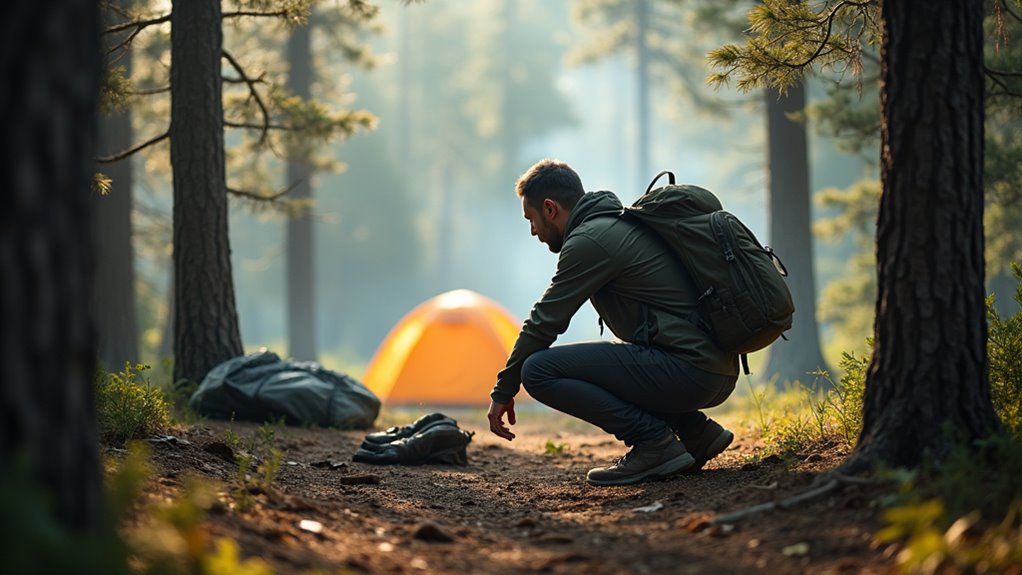
Wilderness bathroom emergencies catch millions of campers unprepared—avoid contamination, fines, and embarrassment with these essential backcountry etiquette secrets.
Over 40 million Americans go camping each year, yet most haven’t mastered the essential skill of wilderness bathroom etiquette. You’ll face this reality whether you’re backpacking remote trails or car camping in undeveloped areas. Getting it wrong doesn’t just create an embarrassing situation—it can contaminate water sources, spread disease, and earn you hefty fines from park rangers. Here’s what experienced campers wish they’d known before their first awkward encounter with nature’s call.
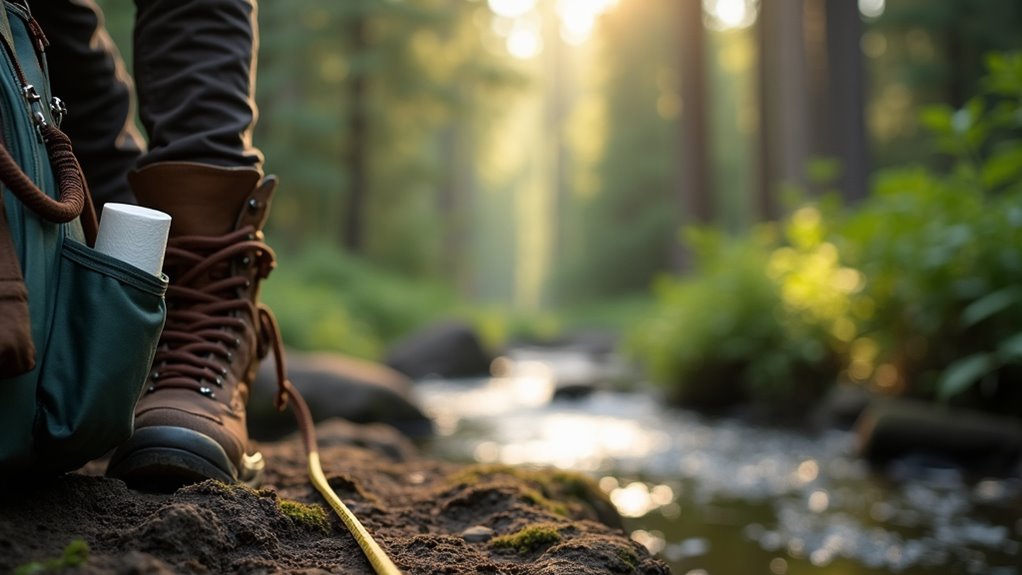
When you’re miles from the nearest restroom, your choice of bathroom location becomes critical for both environmental protection and campground etiquette. The 200-foot rule isn’t arbitrary—it’s the minimum distance you need from water sources, trails, and campsites to prevent contamination and maintain wilderness standards.
You’ll want to measure this distance by pacing it off. Two hundred feet equals roughly 70 adult steps. Choose a spot that’s downhill from water sources but not in a drainage area where runoff flows. Look for organic soil with good decomposition potential, avoiding rocky or sandy areas where waste won’t break down properly.
This distance protects drinking water, prevents unpleasant discoveries by other campers, and keeps wildlife from associating human areas with waste. Following proper bathroom etiquette in the wilderness is just one aspect of ensuring your family camping experience remains enjoyable and respectful to both nature and fellow outdoor enthusiasts.
Once you’ve found your spot, grab your trowel and prepare to dig a hole that’s 6-8 inches deep and 4-6 inches wide. Don’t skimp on depth—shallow holes create odor problems and attract animals.
Start by removing the top layer of organic material like leaves or grass, setting it aside for later.
Dig straight down, creating clean sides rather than a bowl shape. Pack a lightweight camping trowel; makeshift tools like sticks break easily and won’t achieve proper depth.
In rocky terrain, move to softer ground rather than settling for a shallow scrape.
Test soil moisture—overly wet areas won’t decompose waste properly.
Once finished, you’ll backfill with the excavated dirt and replace that organic top layer for natural camouflage.
When exploring new camping sites, take time to scout potential cathole locations during daylight hours so you’re not fumbling around unfamiliar terrain after dark.
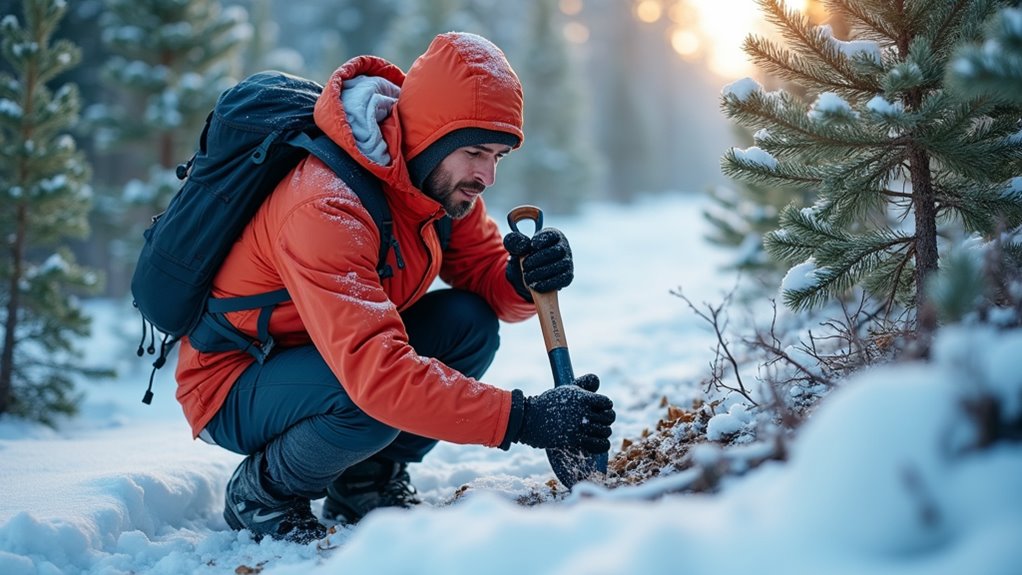
Even experienced campers face situations where standard cathole digging becomes impossible due to frozen ground or solid rock. You’ll need alternative strategies that work effectively while maintaining Leave No Trace principles.
Challenging terrain doesn’t excuse poor waste management—smart campers always have backup plans for responsible disposal.
When standard digging fails, consider these practical solutions:
These methods guarantee you’re prepared regardless of terrain conditions. If you’re planning an extended wilderness trip, consider renting an RV as a base camp option that provides proper sanitation facilities while still allowing you to explore remote areas.
Running out of toilet paper in the wilderness doesn’t have to derail your camping trip if you know what natural and packable alternatives actually work. Smooth stones work surprisingly well—choose flat, non-porous rocks about palm-sized.
Large, soft leaves like mullein, thimbleberry, or lamb’s ear provide excellent natural options, but avoid anything with three leaves or glossy surfaces.
Snow works effectively when packed and shaped properly.
For packable alternatives, bandanas wash easily and pack small.
Baby wipes handle cleanup efficiently but must be packed out.
Tissues and napkins work in emergencies.
Corn cobs, historically proven, still function well.
Always test unfamiliar plants on your skin first to avoid allergic reactions.
When camping in cold weather, these natural alternatives become even more crucial as frozen or wet conditions can make traditional supplies unusable.
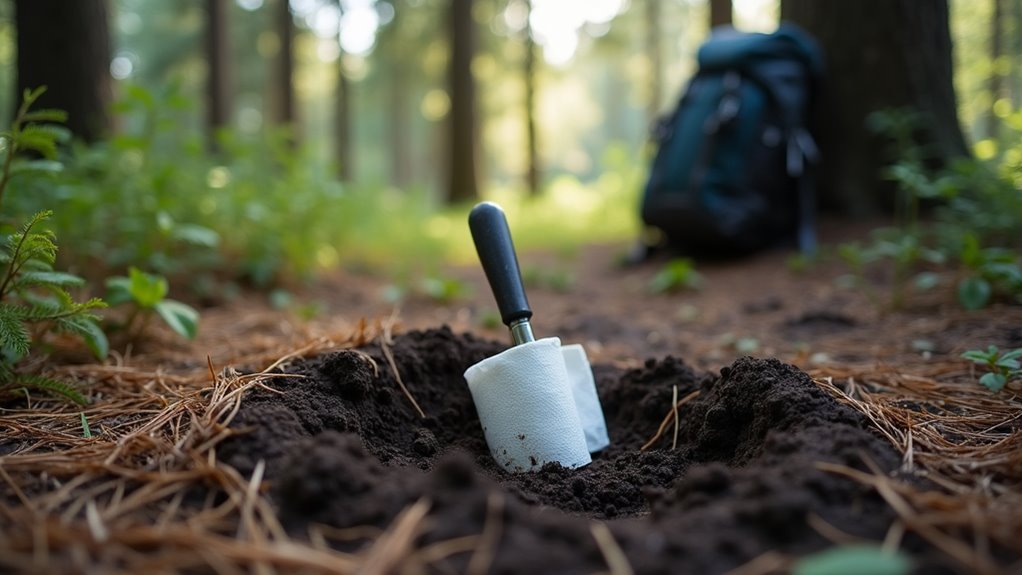
Proper waste disposal matters just as much as finding alternatives when nature calls. You’ll need to understand what stays in the wilderness and what comes back with you to maintain campsite integrity and follow Leave No Trace principles.
Understanding what to pack out versus what can stay behind is fundamental to responsible wilderness camping and environmental stewardship.
Here’s your essential pack-out guide:
Your responsibility extends beyond personal comfort. Wildlife protection, water source preservation, and fellow camper experiences depend on your waste management decisions. Just like selecting comprehensive travel insurance before any outdoor adventure, proper planning for waste management protects you from potential problems and ensures a responsible camping experience.
When you’re surrounded by endless open terrain, creating privacy for bathroom breaks requires strategic thinking and creative use of natural features. Look for natural windbreaks like boulders, fallen logs, or dense shrubs that’ll shield you from view.
Even small depressions in the ground can provide adequate cover when you’re desperate.
If nature doesn’t cooperate, create your own privacy screen. Pack a lightweight tarp or use your camping companions as human shields—just position them strategically while facing away.
Your tent can serve as a visual barrier if you’re camping nearby.
Remember the 200-foot rule: stay that distance from water sources, trails, and campsites. This protects both the environment and maintains courtesy for other outdoor enthusiasts sharing the space.
While you’re taking care of business, consider planning some campfire games to enjoy with your group later in the evening for added entertainment around camp.
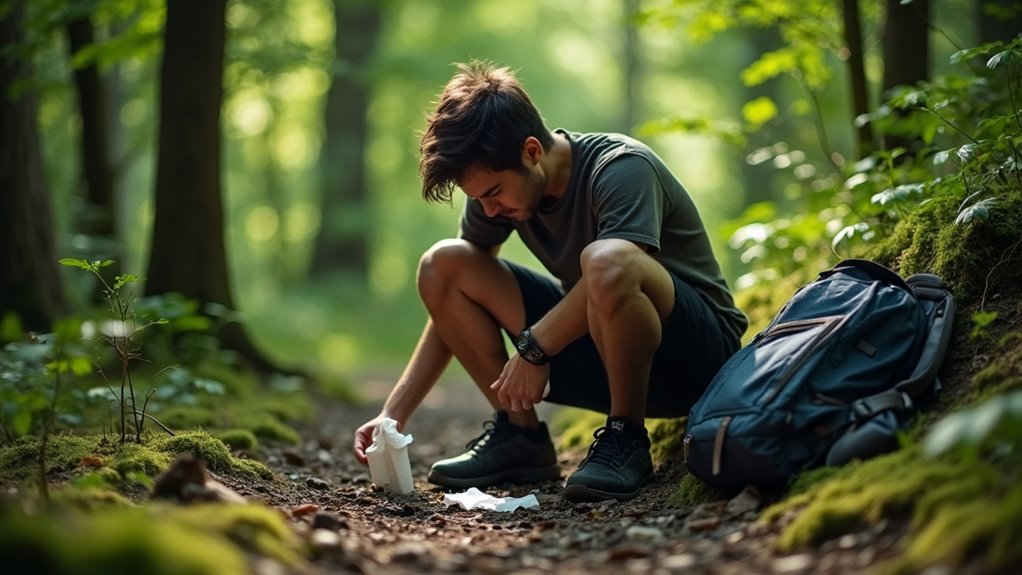
Although stomach troubles strike at the worst possible moments outdoors, you can manage digestive emergencies with proper preparation and quick action.
Pack anti-diarrheal medication before every trip. When symptoms hit, you’ll need immediate access to relief. Stay hydrated by sipping small amounts of water frequently—dehydration compounds the problem quickly in wilderness settings.
Essential stomach emergency supplies:
Find shelter near your campsite but maintain proper distance from water sources. Rest when possible—pushing through severe symptoms worsens your condition and extends recovery time.
Keep all your emergency medical supplies organized and easily accessible using a dedicated Response Pak or similar organizational system designed for camping gear.
Since clean water isn’t available at most campsites, you’ll rely heavily on alcohol-based hand sanitizer and waterless cleaning methods to maintain proper hygiene. Pack at least 60% alcohol content sanitizer and use generously after each bathroom visit. Wet wipes work well for initial cleaning before sanitizing. Keep sanitizer easily accessible—attach a small bottle to your belt or pack strap.
Don’t forget other hygiene essentials: antibacterial soap for when water’s available, disposable gloves for messy situations, and extra wipes for face and body cleaning. Your hands touch everything, so sanitize before eating, cooking, or touching your face. Replace caps tightly since alcohol evaporates quickly. Consider bringing backup sanitizer bottles—you’ll use more than expected during extended camping trips. Proper hygiene becomes even more critical in regions where wild animals may be attracted to human scents and food odors.
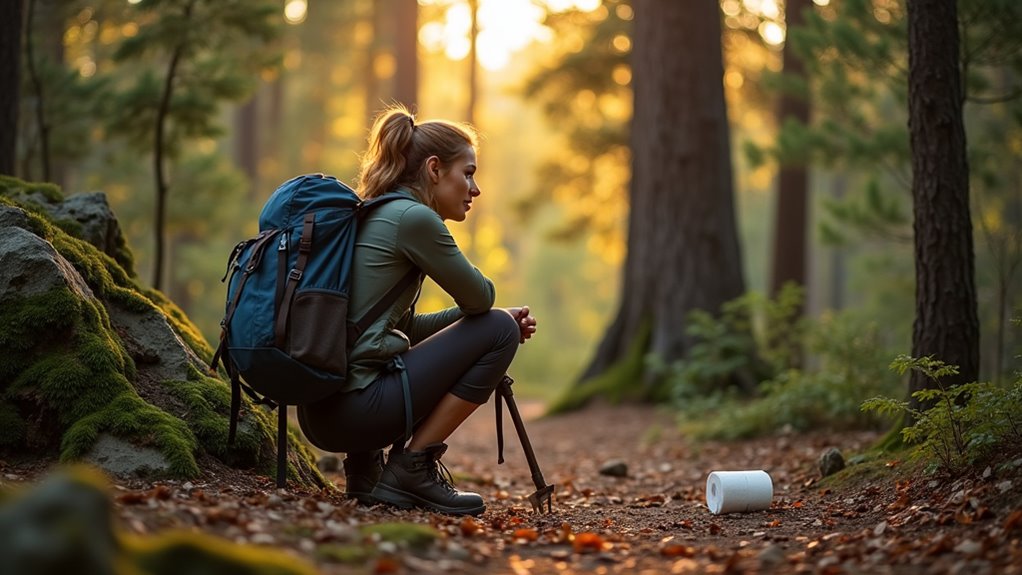
Women face additional considerations beyond basic hygiene when using the bathroom outdoors. You’ll need specific strategies and gear to maintain comfort and cleanliness while camping.
Essential solutions for female campers:
Position yourself downhill from your campsite and dig catholes six inches deep. Always pack out feminine hygiene products. If you’re camping near water, consider whether renting or buying a portable marine toilet could enhance your outdoor experience for extended trips.
When darkness falls and nature calls, you’ll face your most challenging bathroom situation while camping. Keep a headlamp or flashlight within arm’s reach of your sleeping bag. Don’t rely on your phone’s flashlight—you’ll need both hands free.
Scout your nighttime bathroom route during daylight hours. Identify obstacles like rocks, roots, or drop-offs that could cause injury in darkness. Choose a spot that’s close enough for safety but far enough for privacy and Leave No Trace principles.
Wear slip-on shoes to protect your feet from sharp objects and cold ground. Keep toilet paper in a waterproof container near your sleeping area. If you’re using a portable camping toilet, position it strategically before dark.
Always carry a whistle for emergencies and inform tent-mates of your departure. These precautions are just one part of ensuring happy outdoor adventures through proper camping preparation.
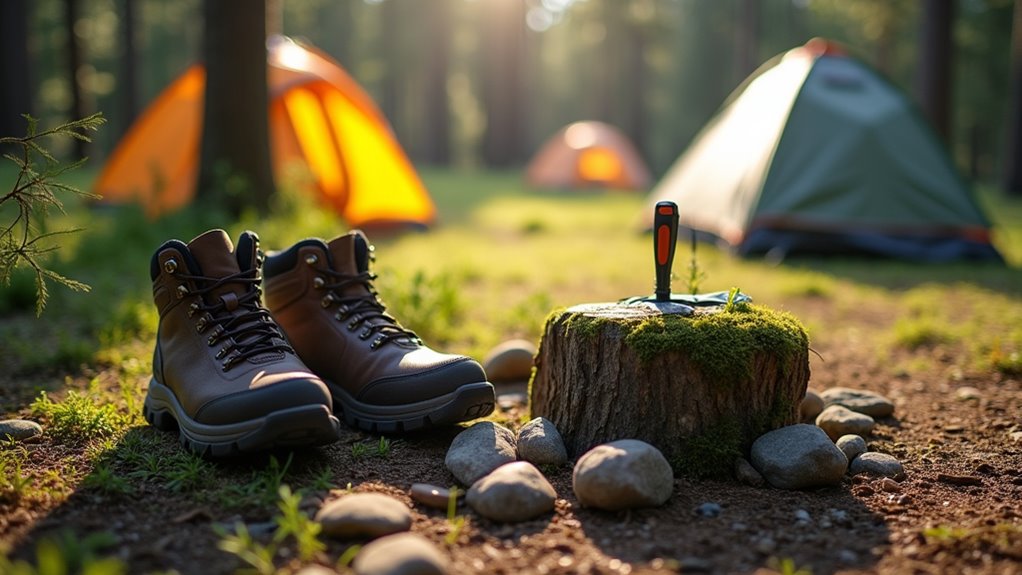
Establishing clear bathroom protocols becomes essential once you’re camping with multiple people, whether it’s family, friends, or organized groups. You’ll need designated areas that maintain privacy while ensuring everyone’s comfort and hygiene standards.
Here’s how to manage group bathroom logistics effectively:
Even seasoned campers can face unexpected bathroom emergencies, so you’ll want to pack essential supplies that’ll save you from uncomfortable situations. Your emergency kit should include toilet paper in waterproof bags, wet wipes for thorough cleaning, and hand sanitizer for proper hygiene.
Pack a lightweight trowel for digging catholes and biodegradable soap for washing up afterward. Don’t forget tissues as backup and a small towel for drying hands.
Include feminine hygiene products regardless of gender—someone in your group might need them. Add anti-diarrheal medication and stomach relief tablets for digestive issues. Plastic bags help pack out waste when Leave No Trace principles require it.
Keep everything organized in a dedicated toiletry bag that’s easily accessible during emergencies. Consider incorporating these bathroom essentials into your overall first-aid kit to ensure you’re prepared for both medical emergencies and sanitation needs during your camping adventure.
You’ve mastered backcountry bathroom basics that’ll serve you well beyond camping. Here’s something most don’t realize: improperly disposed human waste can contaminate groundwater for up to 200 days, affecting entire ecosystems downstream. That’s why your 200-foot rule isn’t just a suggestion—it’s environmental protection in action. Pack your WAG bags, practice your cathole technique at home, and remember that good wilderness bathroom habits separate experienced campers from weekend warriors. You’re now equipped for nature’s call anywhere.